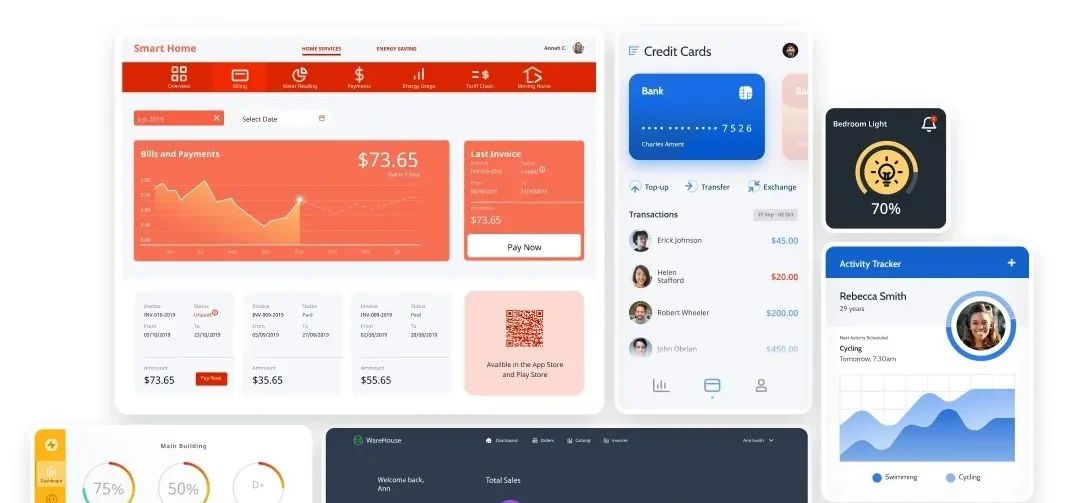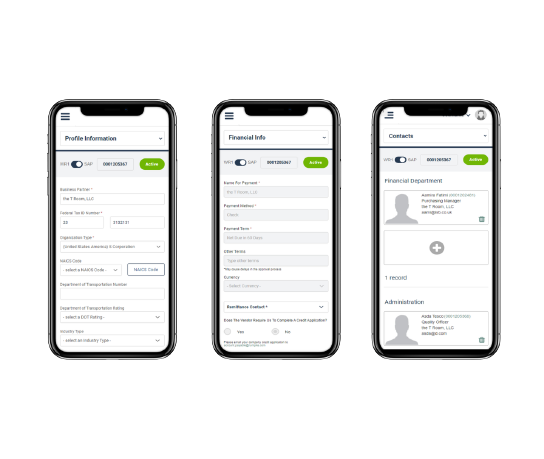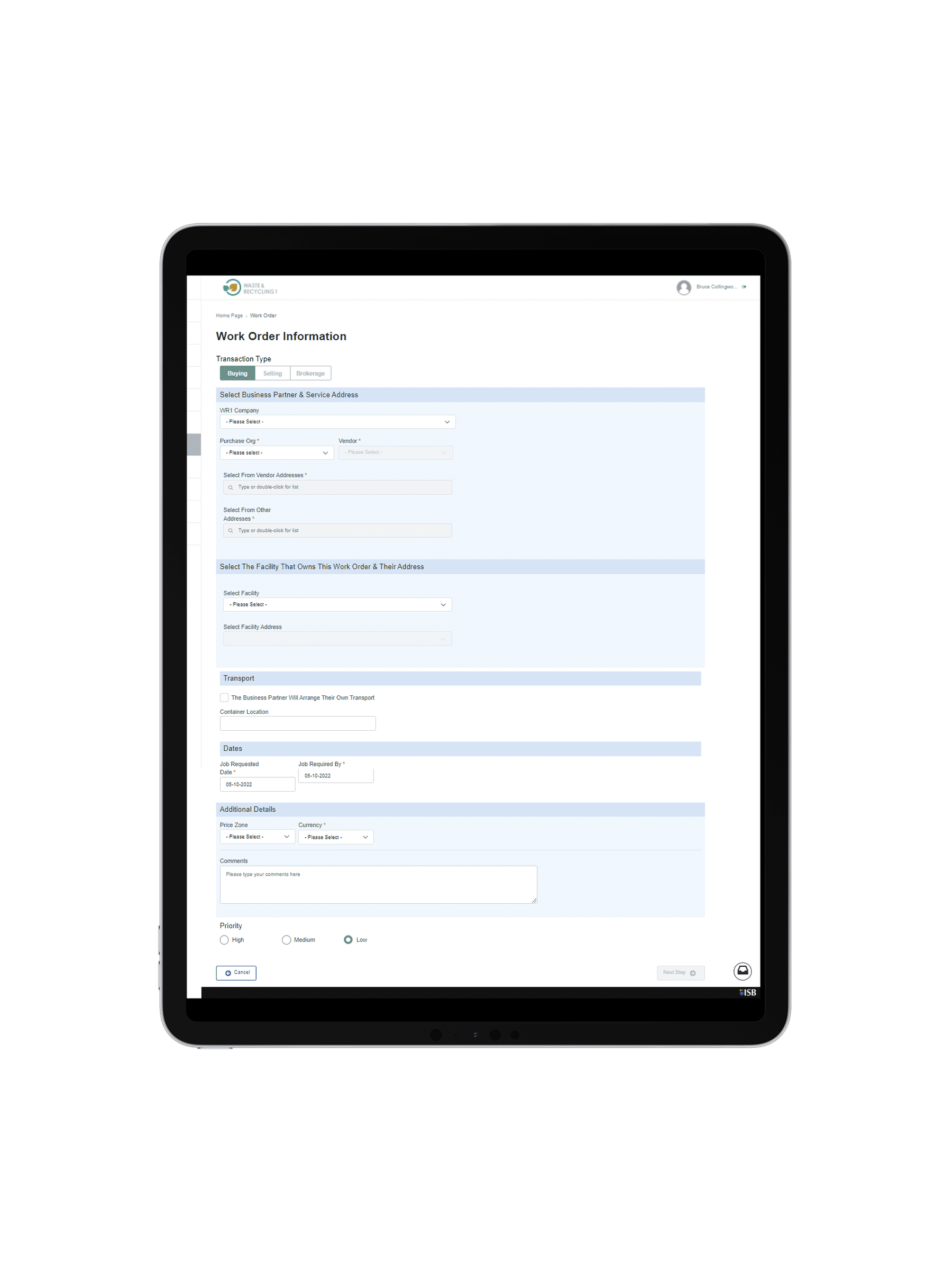Compliance Management App Never miss a deadline, keep all documents in one place and always stay on top with pro-active alerts. GET IN TOUCH → Controlled centrally, executed anywhere. https://www.isb-smartsolutions.com/wp-content/uploads/2022/09/DriverApp-condensed.webm Complex logistics made simple. Automating work order fulfillment, from anywhere. A companion app for vehicle drivers in the execution of work assigned by the central logistics team. The app guides drivers through the complex workflows involved in hauling, logistics, mapping, as well as vehicle, equipment and site safety. It also manages the end-to-end execution of work orders and supports handling of exceptions, e-signatures, electronic documentation/email, connectivity to IOT, all updating the central logistics system in real time. Learn more → Join the smart community Subscribe You have been successfully Subscribed! Ops! Something went wrong, please try again.
Patterns and features to get more from your systems
Patterns and features to get more from your systems. Pritesh Pattni Patterns and features to get more from your systems. Low-code development platforms (LCDPs) have revolutionized the way software is built and deployed. These platforms enable developers to create applications using graphical interfaces and pre-built components, drastically reducing the time and effort required for traditional coding. According to Gartner, by 2024, low-code application development will be responsible for more than 65% of application development activity. Essential low-code features LCDPs have a range of features that support developers to build applications faster, more accurately and with scalability built in. These features include Drag-and-drop interface Pre-built patterns API integrations Data management Security and compliance Analytics and reporting These features help development teams to design and build high-functioning, user-friendly mobile and web apps – from the simple to the highly complex. Low code patterns Pre-built patterns, like those available from the leading low-code OutSystems platform, are available to developers. These patterns are common user interface components and are available for both mobile and reactive web applications, and for more traditional web applications. Patterns are usually customisable, which means you can change the way they look and feel – including adding extra elements, depending on what you need to achieve. For traditional web applications, patterns include: Content Controls Layout Navigation Numbers Responsive Structure Utilities For more common mobile and reactive application development, OutSystems offers a range of pattern options: Adaptive – allowing the app to be viewable on multiple devices and screen sizes, giving the user the best possible experience, whatever device they are using. Content – these allow you to organise content and have pre-built patterns for common elements such as notifications, chat screens and error messages. Interactive maps – this pattern is fully customisable, and there is also a static maps option for including in non-interactive communications such as email. Navigation – a central part of a good user experience is being able to easily navigate around your app. These patterns allow you to manage the way you organise content and direct the user journey. Numbers – patterns to help manage numbers on an application include progress bars, ratings and counters. In more general terms, patterns also include: Reusable components: a library of reusable components that can be easily integrated into different applications. Microservices architecture: an approach to build applications as a collection of loosely coupled services. This delivers flexibility, easier maintenance, and the ability to scale individual components independently. Event-driven architecture: event-driven patterns enable applications to respond to real-time data and user actions. Workflow automation: use low-code features to automate complex business workflows. This helps to streamline processes and build efficiency into your application. Patterns and features from ISB Smart Solutions Our team at ISB Smart Solutions has developed additional features to create several high-level, reusable patterns or methods which are available to be integrated into any new application. There are currently 17 unique patterns available, which can be used alongside our standard OutSystems development to build a responsive, customised app that is designed to meet your particular business challenges. These include: Data upload tool: ISB has followed industry standards to create a framework to load data into OutSystems with standard data load validation, performance and history tracking. ERP integration: send or receive ERP business objects to or from OutSystems, using the integration framework in a proven, standardised way. DocuSign integration: the DocuSign integration framework allows for DocuSign to be connected to OutSystems. Within the management of the framework, mapping is configured and developed for required data into a document developed in DocuSign or Adobe. Multi-currency: Within the multi-currency framework we have built the ability to maintain conditions for spot rates, weekly or monthly rates. Security group management: this is for employees, IT support, customers or vendors who need to access specific functionalities, reports, screens or processes. Our framework allows you to create groups and assign the required reports, screens or processes based on the type of user. Bringing speed and flexibility to your next development The patterns and features available on the OutSystems LCDP, alongside the additional features, patterns and methods that we have built at ISB Smart Solutions gives you access to flexible, intelligent application design without the need for an expensive, long-term hand-coding project. Your application gets to your people – or out to market – faster, and can be continually updated or added to, so your users get the most from it. Scalable with your business and with all the required security elements built in, this development method brings the momentum you need for your next project. Contact us to find out more. Recommended Posts What causes technical debt – and how can you solve it? What causes technical debt – and how can you solve it? Pritesh Pattni What causes technical debt – and how can you solve it? Technical debt is present – to a lesser or greater degree – in every… Read More Low Code – the accelerated way to extend applications Low Code – the accelerated way to extend applications Pritesh Pattni Low Code – the accelerated way to extend applications Business efficiency is the order of the day. In challenging economic and… Read More The best of both worlds: How SAP and OutSystems combine for advanced outcomes The best of both worlds: How SAP and OutSystems combine for advanced outcomes Pritesh Pattni The best of both worlds: How SAP and OutSystems combine for advanced outcomes There’s no doubt that… Read More Where next? I’m an OutSystems Customer looking for Applications to accelerate my journey → I’m an OutSystems customer looking for patterns & features to accelerate my journey → I’m an OutSystems Customer using SAP and looking for an advanced integration engine → I’m an OutSystems customer and I need additional development support for my team →
Low Code – the accelerated way to extend applications
Low Code – the accelerated way to extend applications Pritesh Pattni Low Code – the accelerated way to extend applications Business efficiency is the order of the day. In challenging economic and market conditions, business growth relies on having visibility across the organisation and being able to manage day-to-day processes as efficiently as possible. It’s common for businesses to have disconnected IT systems and disparate data sources. After all, growing businesses take on the technology they need, when they need it. This often translates to systems working in silos, without the connectivity that the business really needs in order to drive strategic growth. This is a challenge that businesses know they have. The problem is that it’s seen as too time-consuming and expensive to fix. The thought of starting a huge IT transformation project puts many business leaders off. There’s a cost-effective, high-performance alternative, though: Low Code Application Platforms – or LCAPs. What is an LCAP? LCAPs are a revolutionary shift in software development, enabling businesses to create applications with minimal hand-coding. Platforms use visual development environments, drag-and-drop features, and pre-built templates to simplify the app creation process. This ‘democratisation’ of application development drives faster and more accurate development and allows teams across the business to collaborate to build technologies that meet business needs. LCAPs are useful on many levels – they are great for designing and building new applications, and also for extending or upgrading existing applications. This is important, because organisations are often using solutions that have been hastily put together to solve a particular problem – and a LCAP approach can help to extend that application into something more useful, more intuitive and able to flex as the organisation changes. What are the attributes of an LCAP? LCAPs shouldn’t be confused with ‘no code’ technologies. In our opinion, LCAPs are best used, not by citizen developers with no coding experience, but by developers who understand the principles of software design and development. That understanding means that your application is in good hands from the very beginning, and developers can take advantage of the attributes of an LCAP without compromising the fundamentals of good application product design. The key attributes of an LCAP include: Drag-and-drop features Pre-built templates User-friendly visual development environment Easy customisation Reduced need for coding expertise Easy to modify for continuous improvement Security and compliance built in Scalability to support business growth LCAP use cases The versatility of LCAPs makes them useful in a wide range of scenarios. In the healthcare sector, for example, LCAPs may be used to develop patient management systems, telehealth applications, or compliance tracking tools. In the financial sector they can be used to build customer onboarding platforms, fraud detection systems, and regulatory compliance solutions. Retail businesses can leverage LCAPs to develop inventory management systems, e-commerce platforms, and customer loyalty programs. LCAPs are valuable for businesses who want to build internal applications that streamline processes or allow the business to gather, analyse and report information in a particular way. They can also help with building external applications which help to improve customer experience, give suppliers an easier way to manage their relationships or allow investors to stay up to date. In short – there’s very little that an LCAP can’t do to help your business. The OutSystems LCAP OutSystems is one of the world’s foremost low code platform providers and is regularly recognised as leading the way both in technological innovation and the results it delivers for its customers. As an OutSystems partner, we know just how good the company’s enterprise LCAP offering is. Earlier this year, it was named by Gartner as a ‘Leader’ in Gartner’s 2023 Magic Quadrant for Enterprise Low Code Platforms (LCAP). OutSystems is consistently a leader in this field because it focuses on allowing developers to manage high-performance software development at pace. Developers and can design and build without any of the hold ups often associated with hand coding. And, because OutSystems can easily integrate with other systems, it can be used to address a wide range of business needs without disrupting day-to-day operations. Most importantly – and one of the main reasons that LCAPs are seeing such a high adoption rate – is the ability to continuously evolve, improve, extend and update applications. This flexibility and scalability means organisations can stay ahead of the game without committing to large budgets or timescales – and get a far superior outcome. Contact us to find out more. Recommended Posts The best of both worlds: How SAP and OutSystems combine for advanced outcomes The best of both worlds: How SAP and OutSystems combine for advanced outcomes Pritesh Pattni The best of both worlds: How SAP and OutSystems combine for advanced outcomes There’s no doubt that… Read More How OutSystems handles technical debt How OutSystems handles technical debt Pritesh Pattni How OutSystems handles technical debt Technical debt has a significant impact on a business. It’s not just about the IT department – technical… Read More The synergy of design, code, and development The synergy of design, code, and development Pritesh Pattni The synergy of design, code, and development Like all disciplines, digital development works best when all the various elements are used… Read More Where next? I’m an OutSystems Customer looking for Applications to accelerate my journey → I’m an OutSystems customer looking for patterns & features to accelerate my journey → I’m an OutSystems Customer using SAP and looking for an advanced integration engine → I’m an OutSystems customer and I need additional development support for my team →
The best of both worlds: How SAP and OutSystems combine for advanced outcomes
The best of both worlds: How SAP and OutSystems combine for advanced outcomes Pritesh Pattni The best of both worlds: How SAP and OutSystems combine for advanced outcomes There’s no doubt that implementing an ERP system into your business is a game changer. Streamlining your systems, automating your processes and supporting compliance and reporting, an ERP system puts your business in a position to make more informed decisions. Many businesses choose SAP as their ERP system. SAP is a global leader in technology solutions, and its ERP solutions are used in businesses all over the world. It brings business functions together, reduces silo-based working and enables real-time insights. It works for businesses with one location in one country, or multiple locations around the world. It might seem like introducing SAP is all you need to put your business in a prime position for growth, but there’s more you can do. And that’s where OutSystems plays its part. OutSystems is a low code platform that allows developers to design and build fast, intelligent applications. By integrating with SAP, OutSystems allows businesses to tailor-make the applications they need, based on the information that SAP holds. Why do you need SAP and OutSystems? Of course, many businesses assume that investing in an ERP is enough. And depending on your ambition, it can be. If your business wants a true competitive advantage, however, or just wants to make life easier for its staff and its customers, it needs to take the next step. That step is to see how you can truly exploit the insights within SAP to leverage ERP benefits faster. It’s often true that just investing in ERP technology isn’t enough. Of course, the technology is there to help you, but it takes time to work out what it can deliver, how that information is most useful to your business and how to use it to direct and support your strategy. What you need is effectively an ERP add-on. A way to make SAP truly bespoke to your sector, your customers and your business plans. For us, that solution is OutSystems. What about integration? Businesses are often nervous about integration. That’s usually because they’ve had their fingers burned in the past. But today’s leading suppliers know that seamless integration is a central criteria when you are selecting a system. So, they make sure that they have the ability to integrate without unnecessary downtime, preparation or cost. We talk about ‘extending’ SAP – that’s because OutSystems increases what’s possible with SAP. Let’s look at how this works: Out-of-the-box ability to connect to major enterprise System of Record platforms like SAP. Wizard-style tool that ensures security and scalability. Easy for developers to integrate both SAP ECC and SAP S/4HANA Ability to create a customised connection and more using the SAP Extensibility API Full end-user authentication integration Working with your development team, you can integrate SAP and OutSystems quickly and easily. Fully instrumented, integrations can generate error logs and performance metrics without the developers having to write any code. This allows any problems to be identified and managed quickly. What can you do with SAP and OutSystems? Using both technologies together gives you endless opportunities to make your business work smarter. 1. Optimising internal processes Every business is looking for efficiencies. Investing in SAP is a big step towards this, and building dedicated new processes using OutSystems can take you to the next level. For example, you could transform inventory tracking, speed up accounts preparation, and improve compliance reporting. 2. Improve customer service Where businesses have very similar product or service offerings, customer service can be the make-or-break area. Use OutSystems and SAP to improve your customer complaints process, design more efficient transportation routes, speed up time from enquiry to proposal or build personalised customer engagement. 3. Engage your teams Build an app that your field sales team can use on the go – both to deliver sales pitches to prospects, and to log relevant sales information. Create a better intranet offering that allows interaction with holiday planning, rota management or wellbeing benefits. Use the power of OutSystems to update processes that free up staff time. These are just a few of the ways you can use intelligent applications, based on information from SAP to build efficiency, high performance and better outcomes into your business. Flexible and scalable Businesses need to be able to pivot quickly. They need access to the information to make informed decisions and they need the ability to roll that information out across staff, customers, stakeholders and regulatory bodies fast. As they grow, businesses need their systems to grow with them. This delivers the flexibility they need to look at new markets, launch new products, open new facilities and take advantage of both market and economic trends. Using SAP and OutSystems together gives businesses this flexibility and support for growth. As a low-code platform, OutSystems doesn’t need long and costly development times: applications can be designed, tested, refined and reworked quickly, so that they are giving the right outcomes and the best value for money. The best of both worlds Smart businesses want smart technology. And using SAP and OutSystems together delivers exactly that. That’s why, at ISB Smart Solutions, we are proud to be both an SAP & an OutSystems Partner, and proud to have integrated OutSystems and SAP into our own solution, Waste & Recycling One. We deliberately chose the platforms we thought were best suited to rapidly building and testing ideas and processes without incurring unnecessary cost or taking too much development time. It’s proved to be a great decision, giving our customers the best of both worlds. Contact us to find out more. Recommended Posts How OutSystems handles technical debt How OutSystems handles technical debt Pritesh Pattni How OutSystems handles technical debt Technical debt has a significant impact on a business. It’s not just about the IT department – technical… Read More The synergy of design, code, and development The synergy of design, code, and development
Is your software future-proofed?
Is your software future-proofed? Pritesh Pattni Is your software future-proofed? As we move rapidly towards full digital transformation, businesses are relying on a raft of software solutions to help them manage their day-to-day operations, store critical data securely, and drive the strategies that promote growth and long-term success. Not all software is equal, though. Older systems are often slower to use, less easy to interrogate, don’t integrate with other systems and can even be at a stage where the software company no longer offers updates or support. Today’s software must be designed and developed with an eye to the future. Whether you are building a system in-house, or buying systems in from elsewhere, the scalability, flexibility and adaptability of the software system must be key considerations. In this article, we talk about why this is so important, and how taking a low code approach could deliver the future proofing you need. Software is changing In fact, this isn’t a recent occurrence. Like all fundamental technologies, software development is changing all the time. Developers live in a fast-paced and competitive environment, where users have certain expectations and demands, and businesses want more software for their money. This can pose problems for the hand-coding approach – the traditional method of software development where developers hand-write their code from scratch. That’s because this is a more time-consuming way to write software – and therefore more expensive. It can also be more prone to errors or bugs, simply because it relies entirely on human authoring and testing. This is why, over the past 20 years, we have seen the emergence of a low code approach. Low code development uses a visual drag-and-drop interface, using pre-designed elements to improve both the speed of development and its accuracy. The ability to use a dedicated platform also promotes better collaboration between developers and their clients – whether they are internal or external – and also allows software to be built that can be updated or scaled quickly and easily. How low code supports future proofing So, low code reduces development time, removes much of the error risk, and helps developers to build flexible software. This in itself supports future-proofing, and there are a number of benefits to this approach: Agile development – using low code platforms supports a more flexible development lifecycle, which allows developers and organisations to respond quickly and accurately to changes in business requirements, market demands or competitive features. The ability to be able to quickly design, test and deploy software applications to help businesses flex to maintain or improve market position. Scalable approach – rather than going through a cycle of constantly upgrading or changing software to meet the demands of a growing business, a low-code approach allows developers to expand the current application to meet new needs. This may be extending functionality to a new department, bringing on board a business that has been acquired, or simply upgrading the software to allow for a more efficient approach. Less technical debt – ‘technical debt’ is a term used to describe software that can no longer deliver what the organisation needs. This slows down productivity and can actively get in the way of growth. With a low code development solution, the code is simpler, the ability to change or adapt is greater and so technical debt declines. Better security – this is a core requirement for all today’s software. Organisations are at constant risk of attack and need to demonstrate that they have put the security of their systems and their data first. While some businesses just focus on security, others also have to demonstrate compliance with both government and regulatory requirements. So today’s development is not just about building a future-proofed user experience; it’s about ensuring the organisation is always meeting or exceeding its security and compliance requirements. Why we use OutSystems OutSystems is a pioneer of the low code approach, and has been developing its platform for the past 20 years. It’s built up a loyal following among professional developers, who can see the numerous benefits of using its intelligence to build software faster, while also retaining control over design and architecture. We are a proud OutSystems partner, using its low code technology to build our industry-leading platform, Waste and Recycling One. We also use OutSystems to build discrete applications for clients, giving them the high quality, future-proofed development they are looking for at a price they can afford. Recommended Posts An evolutionary approach to software engineering An evolutionary approach to software engineering Pritesh Pattni Evolution. The gradual development of something to make it even better. It’s this approach that underpins the low code software… Read More How to choose a low code platform partner How to choose a low code platform partner Pritesh Pattni If you have a technology project or digital transformation programme, you are probably considering a low code solution. Low code offers a range… Read More What is low code technology? And why should you consider it? What is low code technology? And why should you consider it? Pritesh Pattni The demand for new and upgraded technology isn’t going anywhere. The human race continues to adopt new technologies to… Read More Where next? I’m an OutSystems Customer looking for Applications to accelerate my journey → I’m an OutSystems customer looking for patterns & features to accelerate my journey → I’m an OutSystems Customer using SAP and looking for an advanced integration engine → I’m an OutSystems customer and I need additional development support for my team →
Using OutSystems to Extend Your SAP System
Why You Should Use OutSystems to Extend Your SAP System Chris Williams We often talk to SAP customers, partners, and consultants who are worried that OutSystems competes with SAP. But the exact opposite is the case. OutSystems is a complementary tool that you can leverage to extract more value from your SAP platform with less effort. Table of contents: Built-In Flexibility and Integration SAP and OutSystems in Practice Keeping Data in Sync Every business needs to keep up with changing market conditions and new innovations. You need to stay competitive and focused – particularly in tough economic circumstances. From industrial or governmental regulation to global market forces, there are always pressures on your business to be leaner, stronger, and more efficient. To meet these demands, organizations must be flexible – all while maintaining standards in enterprise governance, financial reporting practices, corporate reporting and auditability for stakeholders. And so you need a reliable system that is working with you, not against you. From our perspective, the combination of SAP S4HANA best practice and OutSystems low-code gives you the best of both worlds. Or as defined by Gartner: SAP S4HANA is a world-class “system of record” and OutSystems allows the development of apps, which reflect the “system of differentiation and innovation”. Built-In Flexibility and Integration Why do we think this? Because both software platforms come with best practices, and can work together to give you a more rounded, agile solution — built for purpose, but ready for change. SAP is the original modern-day ERP. It boasts best practices for financial management, including procure to pay, order to cash and master data governance, to name a few. Years of innovation from SAP across all industries allows projects to focus on implementing best practices for budgeting, accounting processes, managing accounting and corporate reporting. Using the SAP configuration system allows customization, setting different business rules within business processes. This in turn allows businesses to implement best business practices in a short time. Organizations benefit from the experience of other users, and the continual development that’s part of the way SAP delivers its product. So, the obvious question is, if SAP is so great, why do you need OutSystems? Simply put, the OutSystems low-code platform delivers additional, ongoing innovation that helps your organization to become more competitive. It allows businesses to rapidly build and test new ideas and business processes without impacting the backbone of the business model. SAP integration with OutSystems is made easy with SAP’s well-defined integration models, processes and structures in SAP BTP. And OutSystems has the ability to orchestrate new business processes with multiple integrations easily – and often multiple applications – through the OutSystems Service Studio. To provide a user with the right information, right level of security to data, system processes for their job role, and to ensure auditable document flow without having to jump between multiple systems is why SAP and OutSystems compliment each other. SAP and OutSystems in Practice When we were designing our waste and recycling solution, Waste & Recycling One, we wanted a loosely-coupled application integration. Our aim was for bi-directional integration of both master data and transactional data. It made sense to use an industry-leading ERP platform – SAP – for the core finance, order to cash and procure to pay systems of record and compliance. We then leveraged OutSystems to build the unique logistical business scenarios and processes that are relevant to the fast-changing waste and recycling industry. You can read the full case study here → This allowed us to build a system that can manage the sector’s compliance, governance and legislation requirements without affecting the core SAP processes. Keeping Data in Sync In this example, if we add a new business partner, the payment terms attributed are important to SAP and are managed there. The NAICS code is important to OutSystems. So we built bi-directional integration to keep the data in sync. When a new business partner service agreement is created, it starts in OutSystems. The partner data is automatically sent to SAP, so by the time the new contract is ready for billing, all the details are in SAP and up to date with the finance data. The order can then be sent to the cash processes and the contract invoice number goes back into OutSystems. It’s a simple but very effective setup. Keeping the data in sync is easy. SAP records changes to the business objects it processes and submits via BTP. OutSystems web application framework uses its API adapters framework to send and receive data during the business process. Importantly, both SAP and OutSystems have very complementary code management between environments. This makes changes, updates, and bugs easy to manage – something we’ll talk about in a separate blog. Find out more about how we can use OutSystems low-code to work alongside your SAP system and deliver even more efficiencies, streamlining your business for the future. Originally posted here: https://www.outsystems.com/blog/posts/extend-sap-system/ Recommended Posts How to choose a low code platform partner How to choose a low code platform partner Pritesh Pattni If you have a technology project or digital transformation programme, you are probably considering a low code solution. Low code offers a range… Read More What is low code technology? And why should you consider it? What is low code technology? And why should you consider it? Pritesh Pattni The demand for new and upgraded technology isn’t going anywhere. The human race continues to adopt new technologies to… Read More What does it mean to work with an OutSystems Partner? What does it mean to work with an OutSystems Partner? Pritesh Pattni What does it mean to work with an OutSystems partner? When you’re planning a software project, you want to look for a development… Read More Where next? I’m an OutSystems Customer looking for Applications to accelerate my journey → I’m an OutSystems customer looking for patterns & features to accelerate my journey → I’m an OutSystems Customer using SAP and looking for an advanced integration engine →
Vendor Portal
Vendor Portal A responsive web application for vendors to manage their own data. GET THE APP → Power to vendors, efficiency to you. The Vendor Portal enables vendors/suppliers to manage their own company data, documentation, compliance, as well as handle all online interactions and messages. Vendors can specify the services they offer and the geographic regions they cover. It also directly integrates with the Bid Manager allowing vendors to be alerted and respond to new contract opportunities and then complete tender responses online. With the Vendor Portal, vendors/suppliers can control their account, define their service offering and take part in bids. Learn more → Account & service offering control. https://www.isb-smartsolutions.com/wp-content/uploads/2022/09/Untitled-1-1.webm Fully responsive interface. DISCUSS YOUR PROJECT → Join the smart community Subscribe You have been successfully Subscribed! Ops! Something went wrong, please try again.
Work Order Manager
Work Order Manager Full management, monitoring and reporting of Work Orders. GET THE APP → Full management, from creation to completion. The Work Order Manager drives operational business at the most granular level. It brings together elements such as; dates, customers, sites, suppliers, container, material code, pricing, the route, the truck/driver, instructions, compliance, and more. Ideally created from the contract, the work order can cover ad-hoc or scheduled activities, linking into the hauling and logistics process as necessary. The Work Order Manager enables full management, monitoring and reporting of Work Orders based on the live status of these jobs as they proceed through multiple business processes to completion. Learn more → Full management, monitoring & reporting. https://www.isb-smartsolutions.com/wp-content/uploads/2022/09/WO.webm Driving Operational Business. DISCUSS YOUR PROJECT → Join the smart community Subscribe You have been successfully Subscribed! Ops! Something went wrong, please try again.
ISB Global Smart Solution’s SAP Partnership
SAP Partnership ISB Global Smart Solutions is a proud SAP Partner. We are proud to partner with SAP, the global leader in Enterprise Resource Planning (ERP) Software. We help clients deploy SAP for the management of business processes, ensuring seamless and full integration with OutSystems. GET IN TOUCH → World leading ERP solutions. SAP delivers control and clear visibility of key governance and compliance management processes. Integrated reporting and analytics provide superior business intelligence, capturing critical information for real-time access and insight. By centralising data management, SAP provides multiple functions with a single view of the truth, in turn creating accelerated workflows, improved operational efficiency, raised productivity, enhanced experiences and increased profits. Learn more → SAP Enterprise Resource Planning (ERP) transforms business with integrated, intelligent functions. It delivers automated company-wide processes. It uses has industry best practices and employs real-time embedded analytics. SAP S/4 HANA Cloud ERP is a solution for large enterprises. It has built-in intelligent technologies including AI, machine learning, and advanced analytics. This technology is helping companies to adopt new business models & manage change at speed. SAP Business One ERP for small companies delivers a single affordable solution to gain greater insight. This allows companies to make informed decisions based on real-time information. Therefore, you can focus on driving profit and growth. SAP ByDesign ERP for mid-size companies delivers pre-built processes in finance, sales, product management, and purchasing on a single unified solution. This allows you to connect all functions across your business with best practices and analytics. Plan your project → Plan your project → Join the smart community Subscribe You have been successfully Subscribed! Ops! Something went wrong, please try again.
ISB Global Smart Solution’s AWS Partnership
AWS Partnership ISB Global Smart Solutions is a proud AWS Partner, this partnership allows us to use AWS to offer industry-leading computing, security, flexibility, and scalability. GET IN TOUCH → The world’s most comprehensive cloud platform. Amazon Web Services (AWS) is the most broadly adopted cloud platform in the world, offering over 200 fully-featured services from data centres globally. Millions of customers use AWS to lower costs, become more agile, and innovate faster. Learn more → Reliable, scalable infrastructure on demand. Advanced security standards to eliminate human error. Simple and easy application management. Secure computing with compliance certifications. Industry-leading storage performance, flexibility, and scalability. Plan your project → Plan your project → Join the smart community Subscribe You have been successfully Subscribed! Ops! Something went wrong, please try again.











